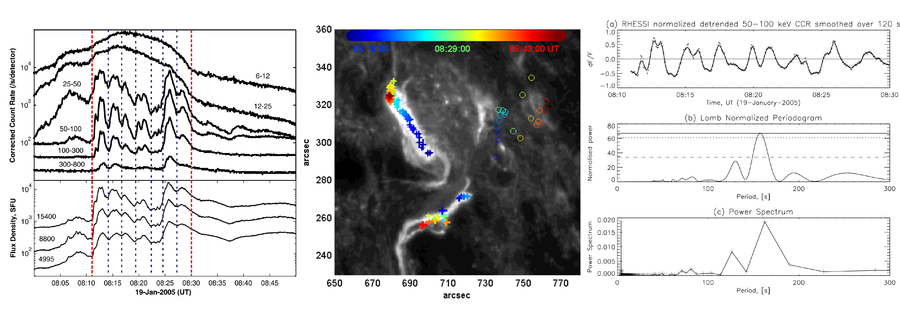Slow Magnetoacoustic Waves in Two-Ribbon Flares
From RHESSI Wiki
Ivanzimovets (Talk | contribs) (→Two Bright Peculiarities of the Energy Release Source Motions Along the Flare Arcade Axis) |
Ivanzimovets (Talk | contribs) (→Two Bright Peculiarities of the Energy Release Source Motions Along the Flare Arcade Axis) |
||
| Line 20: | Line 20: | ||
Both features are schematically represented by Cartoon in '''Figure 2'''. | Both features are schematically represented by Cartoon in '''Figure 2'''. | ||
| - | [[File: | + | [[File:Cartoon_qpp.png|thumb|center|600px|'''Figure 2''': Cartoon of the processes of energy release source motions along the flare arcade axis accompanied by quasi-periodic pulsations of non-thermal hard X-ray emission.]] |
== Possible Interpretation I: Asymmetric Filament Eruption == | == Possible Interpretation I: Asymmetric Filament Eruption == | ||
Revision as of 05:21, 6 March 2011
Contents |
Introduction
The physical processes operating in solar energy releases are still unclear and under very active scrutiny. The understanding of three-dimensional morphology and dynamics of large, eruptive, two-ribbon flares can shed light on this problem. This Nugget aims to discuss one aspect of flare development in three-dimensional space, namely the processes of energy release source motions along the magnetic neutral line.
According to the more or less "standard picture" of large eruptive flares oppositely directed magnetic field lines being in the form of arcade of magnetic loops are stretched by some non-stationary agent (e.g. by an erupting twisted magnetic flux rope or filament) to form a quasi-vertical current sheet in the corona. Here, in the current sheet, magnetic field lines can reconnect converting free magnetic energy to thermal and kinetic energy of plasma and charged particles causing a multitude of secondary flaring effects.
Unfortunately, the "standard picture" is essentially two-dimensional, implying translational symmetry along the flare arcade axis. Being capable to represent a lot of observational effects in the planes of magnetic loops, it does not represent any flare development in the third direction ortogonal to the loop planes - along the flaring arcade axis and the magnetic neutral line. But often large, eruptive, two-ribbon flares develop predominantly just in this direction - in a number of observations energy release is seen to propagate mainly along the flaring arcade axis. In particular, RHESSI made a great contribution in this issue observing an impressive motions of non-thermal hard X-ray sources along the flare arcade axis, the flare ribbons, and the neutral line (e.g. see Nugget 4 and Nugget 6, and Figure 1 below).
Two Bright Peculiarities of the Energy Release Source Motions Along the Flare Arcade Axis
Such type of energy release source motions in eruptive, two-ribbon solar flares has two bright and exciting features:
- the still unknown triggering disturbances observed to propagate along the flare arcade axis at the speed of a few tens km/s, well below the Alfven and sound speeds;
- it is often accompanied by wavetrains of quasi-periodic pulsations with typical periods from a few seconds up to several tens of seconds observed in light curves of non-thermal hard X-ray and microwave emissions, and each pulsation is emitted sequentially from different magnetic loops of the flaring arcade.
The second feature is illustrated on Figure 1 below using an example of the January 19, 2005 eruptive, two-ribbon solar flare. One can see obvious quasi-periodic pulsations with a period of about 160 s by the naked eye. The presence of quasi-periodicity in the light curves of non-thermal hard X-ray and microwave emissions is clearly confirmed by the standard time-series analysis, such as calculation of Power Spectra or the Normalised Lomb Periodograms. Also one can see that the sources of non-thermal hard X-ray emission (50-100 keV) move predominantly along the main flare ribbons (with an average speed of about 60 km/s) during the time interval, when quasi-periodic pulsations are observed. (See also Nugget 4 and Nugget 6 for example of the flare with the very similar properties.)

Both features are schematically represented by Cartoon in Figure 2.
Possible Interpretation I: Asymmetric Filament Eruption
As it was mentioned above the nature of the hypothetical triggering disturbances propagating along the flare arcade axis is unclear yet. This is mainly due to the lack of detailed spatially-resolved observations. Thus, at the present level of our development we can only speculate expressing one or another hypothesis.
One of the possible and attractive interpretations based on a tether cutting scenario was proposed in Nugget 6. According to this scenario magnetic flux rope (filament) can erupt nonuniformly along the flare arcade axis and stretch different magnetic loops to different extent each moment, thus causing their ignition by magnetic reconnection sequentially. Consequently, one can observe that the energy release source propagates mainly along the flare arcade axis and that the flux of hard X-ray and microwave emissions is modulated in accordance with this process. It is worth noting that the asymmetrical flux rope (filament) eruptions were already observed many times, thus giving a strong evidence in favor of this scenario.
Nevertheless, one might wonder: is it easy to explain features 1 and 2 mentioned above in the frame of this scenario without resorting to additional assumptions?
